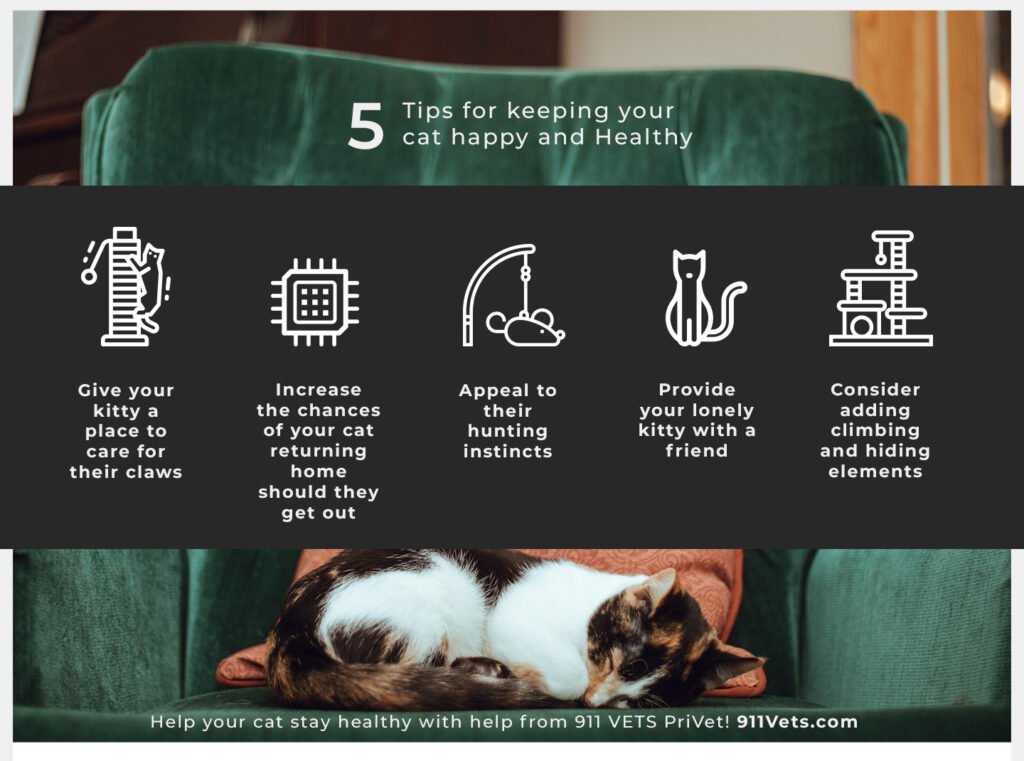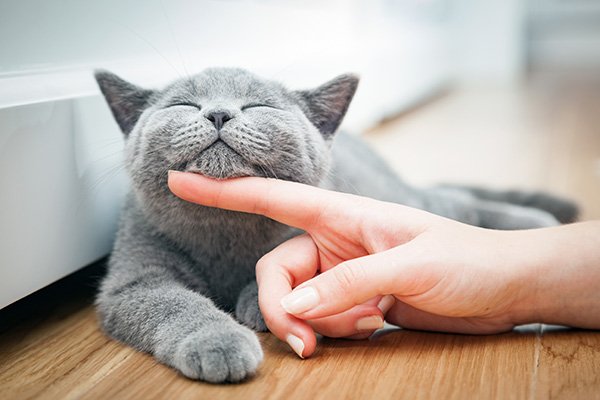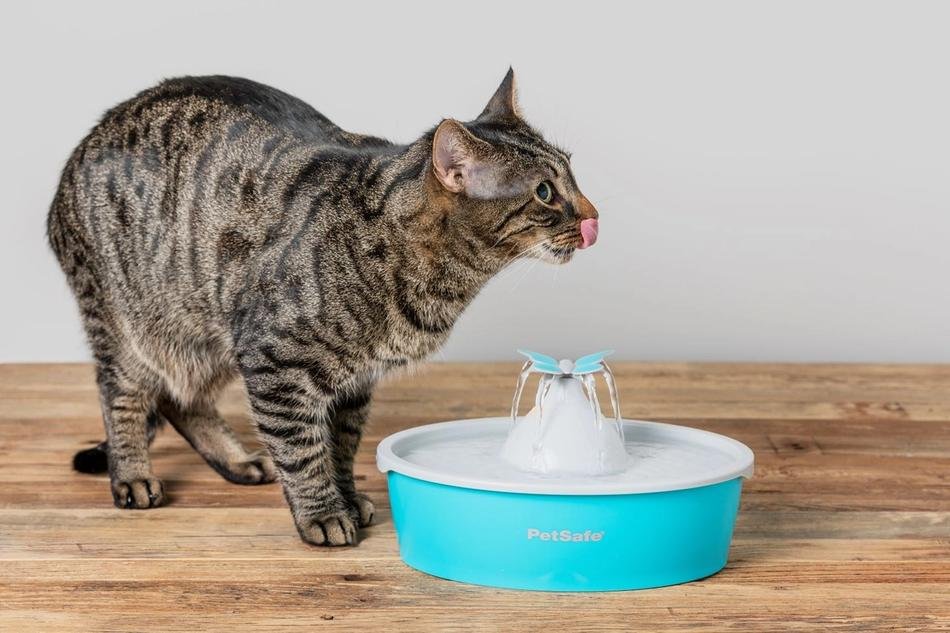If you have a feline friend at home, then you know just how important it is to ensure their health and happiness. From their playful antics to their soothing purrs, cats bring so much joy to our lives. In this article, we’ll explore some simple yet effective tips on how to keep your cat healthy and happy. So, grab a cup of tea, find a cozy spot, and let’s dive into the world of feline care together.
Proper Nutrition
Choose a balanced diet
Proper nutrition is essential for keeping your cat healthy and happy. When it comes to feeding your cat, it’s important to choose a balanced diet that meets their nutritional needs. Look for high-quality cat food that contains a good balance of protein, carbohydrates, and fats. Avoid foods with artificial additives or fillers. It’s also crucial to provide fresh, clean water at all times to keep your cat hydrated.
Provide fresh water
Water is essential for your cat’s overall health and well-being. It helps regulate body temperature, aids in digestion, and flushes out toxins. Make sure to provide fresh, clean water in a clean bowl daily. Cats can be finicky about their water, so some cats prefer running water. You can consider using a cat water fountain to provide a constant flow of fresh water, which may entice your cat to drink more.
Avoid overfeeding
Maintaining a healthy weight is crucial for your cat’s overall health. Overfeeding can lead to obesity, which can increase the risk of various health problems. Follow the feeding guidelines provided by the cat food manufacturer and avoid giving excessive treats or table scraps. It’s best to consult with your veterinarian to determine the appropriate portion sizes for your cat based on their age, activity level, and overall health.
Consider age-specific food
Just like humans, cats have different nutritional needs at different life stages. Kittens require more calories and nutrients for growth, while adult cats need a balanced diet to maintain their weight. Older cats may benefit from senior cat food that supports joint health and contains antioxidants for overall wellness. Consider switching to age-specific food based on your cat’s life stage and consult with your veterinarian for dietary recommendations.
Consult with a veterinarian for dietary recommendations
Each cat is unique, and their nutritional needs may vary based on their health condition or specific dietary requirements. It’s always a good idea to consult with a veterinarian to determine the best diet for your cat. They can provide personalized recommendations based on your cat’s age, weight, breed, activity level, and any underlying health issues. Regular visits to the veterinarian will ensure that your cat’s nutritional needs are being met and any dietary adjustments can be made as needed.
Regular Veterinary Care
Schedule annual check-ups
Regular veterinary care is vital to maintaining your cat’s health and catching any potential health issues early. Schedule annual check-ups with your veterinarian, even if your cat appears healthy. During these visits, your veterinarian will perform a thorough physical examination, check for any signs of illness, and may recommend preventive measures such as vaccinations or parasite control.
Stay up to date on vaccinations
Vaccinations are crucial for preventing various contagious diseases in cats. Make sure to stay up to date on your cat’s vaccinations as recommended by your veterinarian. Vaccinations protect your cat against diseases such as rabies, feline distemper, and feline leukemia. Your veterinarian will guide you on the appropriate vaccination schedule based on your cat’s age, lifestyle, and risk factors.
Monitor dental health
Dental health is often overlooked but plays a significant role in your cat’s overall well-being. Poor oral hygiene can lead to dental diseases such as gum inflammation, tooth decay, and even tooth loss. Monitor your cat’s dental health regularly and look for signs of dental problems, including bad breath, difficulty eating, or swollen gums. Regular dental cleanings by a veterinarian and dental care at home, such as brushing your cat’s teeth, can help prevent dental issues.
Schedule spaying or neutering
Spaying or neutering your cat not only prevents unwanted litters but also offers several health benefits. Spaying eliminates the risk of uterine infections and greatly reduces the risk of mammary tumors. Neutering decreases the chances of testicular cancer and reduces behavioral issues such as marking territory or roaming. Consult with your veterinarian to determine the appropriate time for spaying or neutering your cat.
Recognize signs of illness and seek prompt veterinary attention
Cats are known for hiding signs of illness, so it’s important to be vigilant and recognize any potential health issues. Monitor your cat’s behavior, appetite, and litter box habits closely. Look out for symptoms such as sudden weight loss, excessive drinking or urination, changes in bathroom habits, vomiting, diarrhea, or lethargy. If you notice any concerning signs, seek prompt veterinary attention. Early detection and treatment of illnesses can greatly improve your cat’s prognosis and quality of life.

This image is property of images.booksense.com.
Exercise and Enrichment
Engage in interactive play
Exercise and play are essential for your cat’s physical and mental well-being. Engage in interactive play sessions with your cat using toys such as wand toys or feather teasers. These toys simulate hunting behavior and provide exercise and mental stimulation. Set aside dedicated playtime each day to keep your cat active and fulfilled.
Provide toys and scratching posts
Cats have a natural instinct to scratch, so it’s important to provide appropriate outlets for this behavior. Invest in scratching posts or boards and place them in different areas of your home. This will help prevent your cat from scratching furniture or carpets. Additionally, provide a variety of toys to keep your cat entertained, such as catnip toys, plush toys, or puzzle toys.
Create an indoor cat-friendly environment
If your cat is strictly indoors, it’s important to create an environment that stimulates their natural instincts. Set up perches or cat trees near windows, so your cat can observe the outside world and bask in the sun. Create hiding spots with boxes or tunnels where your cat can retreat and feel safe. Consider using vertical wall shelves or shelving units to provide additional climbing opportunities.
Consider leash-training for outdoor exploration
Leash-training your cat can allow them to safely explore the outdoors while keeping them under your supervision. Start by introducing your cat to a harness gradually and reward them with treats and positive reinforcement. Once your cat is comfortable wearing the harness, attach a leash and begin short outdoor excursions. Always supervise your cat closely and be mindful of their surroundings.
Promote mental stimulation with puzzle toys or treat dispensers
Cats are intelligent animals that require mental stimulation to prevent boredom and behavioral issues. Invest in puzzle toys or treat dispensers that require your cat to work for their food or treats. These toys provide mental enrichment and encourage problem-solving skills. Rotate the toys periodically to keep your cat engaged and challenged.
Grooming
Regular brushing
Regular brushing helps keep your cat’s coat healthy and prevents mats or tangles. It also allows you to bond with your cat and monitor their skin for any abnormalities. Use a brush specifically designed for cats and groom your cat gently in the direction of their fur. Be mindful of sensitive areas such as the belly or tail. If your cat has a long coat, consider scheduling regular grooming sessions with a professional groomer.
Nail trims
Trimming your cat’s nails regularly is important for their comfort and to prevent them from getting caught on objects or scratching furniture. Use a cat nail trimmer or human nail clippers with a straight edge, and be cautious not to cut too close to the quick (the pink area inside the nail). If you’re unsure or uncomfortable with trimming your cat’s nails, consult with a veterinarian or professional groomer for assistance.
Oral hygiene care
Maintaining good oral hygiene is essential for preventing dental diseases in cats. Brushing your cat’s teeth regularly helps remove plaque and tartar buildup. Use a toothbrush and toothpaste specifically designed for cats, as human toothpaste can be toxic to them. Start by introducing toothbrushing gradually and reward your cat with treats and praise. If your cat is resistant to toothbrushing, consider alternative dental care options such as dental treats or water additives.
Prevent and control fleas, ticks, and parasites
Fleas, ticks, and parasites can cause various health issues in cats, including skin irritation, anemia, and the transmission of diseases. Regularly check your cat for fleas or ticks, especially if they spend time outdoors. Use veterinarian-approved flea and tick prevention products to protect your cat. Additionally, it’s important to administer regular deworming treatments to prevent internal parasites.
Monitor and clean ears
Ear infections are common in cats, especially those with long ears or allergies. Regularly inspect your cat’s ears for any redness, swelling, discharge, or a foul odor. Gently clean the outer parts of the ears with a veterinarian-approved ear cleaning solution and cotton balls. Avoid using cotton swabs or inserting anything deep into your cat’s ears, as this can cause injury. If you notice any concerning signs or your cat is experiencing discomfort, consult with your veterinarian.

This image is property of dta0yqvfnusiq.cloudfront.net.
Stress Reduction
Create a calm and quiet space
Cats are sensitive to their environment and can become stressed by loud noises or constant activity. Create a calm and quiet space in your home where your cat can retreat and relax. This can be a designated room or a cozy corner with a comfortable bed or blanket. Ensure that this space is free from any potential stressors, such as noisy appliances or frequent foot traffic.
Provide hiding spots
Cats often seek hiding spots when they feel anxious or overwhelmed. Provide various hiding spots throughout your home, such as cardboard boxes, tunnels, or cozy cat caves. These hiding spots offer a sense of security and give your cat a safe place to retreat when they need some alone time. Avoid forcefully removing your cat from their hiding spot, as this can increase their stress levels.
Use pheromone diffusers or sprays
Pheromone diffusers or sprays can help create a calm and comforting atmosphere for your cat. These products mimic the natural pheromones that cats release when they feel safe and secure. Place a diffuser in the areas where your cat spends the most time or use a spray on your cat’s bedding or favorite spots. Pheromone products can be effective in reducing stress-related behaviors such as marking or aggression.
Introduce gradual changes
Cats are creatures of habit and can become stressed by sudden changes in their environment. When introducing any changes, such as rearranging furniture or bringing in new household members, do so gradually. Allow your cat to adjust at their own pace, and provide familiar objects or scents to help them feel more comfortable. Give your cat extra attention and reassurance during periods of change to minimize stress.
Prevent bullying or conflicts with other pets
If you have multiple pets in your household, it’s important to prevent bullying or conflicts that can cause stress for your cat. Provide separate food and water bowls, litter boxes, and sleeping areas for each pet. Monitor their interactions and intervene if any aggressive behavior occurs. If necessary, consult with a veterinarian or animal behaviorist for guidance on managing multi-pet dynamics and reducing stress.
Cat-Proofing Your Home
Secure toxic substances and plants
Cats are curious by nature and may come into contact with toxic substances or plants in your home. Keep household cleaners, chemicals, medications, and potentially toxic plants out of your cat’s reach. Store these items in closed cabinets or lock them away. It’s also important to research which plants are toxic to cats and remove them from your home or place them in inaccessible areas.
Protect electrical cords
Electrical cords can be tempting for cats to chew on, which can result in serious injury or electrical shock. Keep cords out of your cat’s reach by using cord organizers or concealing them behind furniture. You can also use cord covers or deterrent sprays to discourage your cat from chewing on them. Regularly inspect cords for any signs of damage, and replace them if necessary.
Remove small objects that can be swallowed
Small objects such as rubber bands, coins, or small toys pose a choking hazard if ingested by cats. Take a thorough look around your home and remove any small objects that your cat could potentially swallow. Keep small items stored safely in drawers or containers to prevent accidental ingestion.
Ensure windows and balconies are safe
Open windows or balconies can pose a significant risk for cats, especially if they are not properly secured. Ensure that all windows have sturdy screens or safety nets to prevent falls. If you have a balcony, make sure it is completely enclosed so that your cat cannot squeeze through or climb over. Supervise your cat when they are near open windows or balconies to prevent accidents.
Eliminate hazards like open dryer or washer
Cats are notorious for finding cozy spots to nap in unexpected places, including open dryers or washers. Always double-check these appliances before using them to ensure that your cat is not inside. Keep the doors closed when not in use or consider using childproof locks to prevent access.

This image is property of suntechmed.com.
Hygiene and Litter Box
Keep litter box clean
A clean litter box is essential for your cat’s hygiene and well-being. Scoop the litter box at least once a day to remove waste and clumps. Regularly change the litter and thoroughly clean the litter box with mild, unscented soap and water. Avoid using harsh chemicals or strong-smelling cleaners that may deter your cat from using the litter box.
Choose the right litter
Choosing the right litter is important to ensure your cat’s comfort and encourage consistent litter box usage. Cats may have preferences for certain litter types, so it may require some trial and error to find the right one. Consider factors such as odor control, dust levels, and texture. Avoid litters with strong fragrances, as these can be overwhelming for cats with sensitive noses.
Provide multiple litter boxes in multi-cat households
If you have multiple cats in your household, it’s important to provide enough litter boxes to prevent competition or territorial issues. The general rule of thumb is to have one litter box per cat plus an extra. Place the litter boxes in different areas of your home, ensuring they are easily accessible and offer privacy. Regularly clean and maintain each litter box to keep them appealing to your cats.
Consider litter box location
The location of the litter box can greatly influence your cat’s willingness to use it. Choose a quiet and easily accessible location for the litter box, away from high-traffic areas or loud appliances. Cats prefer privacy when using the litter box, so avoid placing it in busy or noisy areas. Additionally, make sure the litter box is on a stable surface to prevent tipping or sliding.
Observe litter box habits for any changes
Monitoring your cat’s litter box habits is important for detecting any potential health issues. Pay attention to the frequency and consistency of your cat’s urination and bowel movements. Any changes, such as increased or decreased frequency, straining, blood in the urine or feces, or accidents outside the litter box, should be addressed promptly with a veterinarian.
Social Interaction
Spend quality time with your cat
Cats are social animals and require social interaction with their human companions. Make it a point to spend quality time with your cat each day. Engage in activities they enjoy, such as playing, grooming, or simply relaxing together. Regular interaction strengthens the bond between you and your cat and promotes their overall well-being.
Encourage interactive play with family members
In addition to spending time with you, it’s important for your cat to interact with other family members. Encourage interactive play between your cat and family members, including children, to provide socialization and mental stimulation. Teach children to handle cats gently and respect their boundaries. Supervise all interactions to ensure the safety and well-being of both your cat and family members.
Gradually introduce new people or pets
Introducing new people or pets into your cat’s environment can be stressful for them. Take time to introduce new individuals or animals gradually and in a controlled manner. Allow your cat to approach and investigate at their own pace, and provide positive reinforcement and treats during the process. Offer safe spaces for your cat to retreat to if they feel overwhelmed.
Provide vertical spaces for climbing and observing
Cats have a natural instinct to climb and explore their environment from an elevated vantage point. Provide vertical spaces such as cat trees, tall shelves, or window perches for your cat to climb and observe their surroundings. These vertical spaces not only provide enrichment but also offer a sense of security for your cat.
Consider getting a companion for your cat
If you have a single cat, you may consider getting a companion to provide social interaction and companionship. However, it’s important to introduce new cats gradually and ensure compatibility between them. Consult with a veterinarian or animal behaviorist for guidance on introducing a new cat to your household and managing multiple cats.

This image is property of cdn.sanity.io.
Monitoring Weight and Body Condition
Regularly weigh your cat
Maintaining a healthy weight is crucial for your cat’s overall health and longevity. Regularly weigh your cat using a scale specifically designed for pets. Keep a record of their weight and monitor any changes over time. Sudden weight loss or weight gain can be an indicator of an underlying health issue, so consult with your veterinarian if you notice any significant changes.
Observe body shape and appearance
In addition to weighing your cat, it’s important to observe their body shape and appearance. A healthy cat should have a slightly rounded abdomen without excessive fat deposits. You should be able to feel their ribs without significant fat covering. If you notice your cat becoming overweight or underweight, consult with your veterinarian to assess their body condition.
Adjust feeding portions accordingly
Based on your cat’s weight and body condition, adjust their feeding portions as necessary. If your cat is overweight, consult with your veterinarian for recommendations on a weight loss plan. This may involve reducing the amount of food or switching to a lower-calorie diet. If your cat is underweight, your veterinarian may recommend increasing their portion sizes or switching to a more calorie-dense food.
Consult with a veterinarian for weight management
If you’re unsure about your cat’s weight or need guidance on weight management, consult with your veterinarian. They can assess your cat’s body condition, provide dietary recommendations, and create a weight management plan tailored to your cat’s needs. Regular follow-up appointments will allow your veterinarian to monitor your cat’s progress and make any necessary adjustments.
Travel and Transport
Get a secure and comfortable carrier
A secure and comfortable carrier is essential for transporting your cat safely. Choose a carrier that is well-ventilated, sturdy, and of appropriate size for your cat. It should have a secure latch or locking mechanism to prevent escapes. Place a soft bedding or towel inside the carrier to provide comfort during travel.
Introduce the carrier gradually
Many cats associate the carrier with negative experiences, such as trips to the veterinarian. To help your cat feel more comfortable with the carrier, introduce it gradually and associate positive experiences with it. Leave the carrier open and accessible in your home with treats or toys inside. Gradually increase your cat’s exposure to the carrier by feeding meals or offering treats inside. This positive association will make future trips less stressful for your cat.
Take short practice trips
Before embarking on a long journey, take short practice trips with your cat to help them acclimate to travel. Start with short drives around the block and gradually increase the duration. Monitor your cat’s behavior during the trips and provide reassurance and treats as needed. These practice trips will help your cat become more comfortable and reduce travel-related stress.
Ensure proper ventilation and temperature
When travelling with your cat, it’s important to ensure proper ventilation and a comfortable temperature inside the carrier and the vehicle. Avoid exposing your cat to extreme temperatures, whether it’s too hot or too cold. Ensure that there is adequate airflow inside the carrier, either through vent openings or by leaving a portion of the carrier uncovered.
Offer familiar objects or blankets for comfort
To help your cat feel more secure during travel, offer familiar objects or blankets inside the carrier. These items will provide a sense of familiarity and comfort in an unfamiliar environment. Avoid using heavily scented items or materials that could pose a choking hazard.
In conclusion, keeping your cat healthy and happy requires a holistic approach that encompasses proper nutrition, regular veterinary care, exercise and enrichment, grooming, stress reduction, cat-proofing your home, hygiene and litter box maintenance, social interaction, monitoring weight and body condition, and safe travel practices. By following these guidelines, you can provide your feline companion with the best possible care and ensure their overall well-being throughout their life. Remember to consult with a veterinarian for personalized recommendations and advice tailored to your specific cat’s needs. With your love, attention, and proper care, your cat can live a long and fulfilled life by your side.

This image is property of i.ytimg.com.

